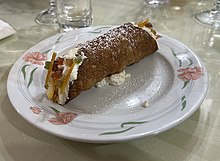 | |
| Type | Pastry |
|---|---|
| Place of origin | Italy |
| Region or state | Sicily |
| Main ingredients | Fried pastry dough, ricotta filling [1] |
| Variations | Kannoli (
Malta) Kanojët ( Albania) |


Cannoli ( /kəˈnoʊliː/, Italian: [kanˈnɔːli]; Sicilian: cannola, Sicilian: [kanˈnɔːla]; sg.: cannolo) are a pastry consisting of a tube-shaped shell of fried pastry dough, filled with a sweet, creamy filling containing ricotta—a staple of Sicilian cuisine. [2] [3] They range in size from 9 to 20 centimetres (3+1⁄2 to 8 in). In mainland Italy, they are commonly known as cannoli siciliani ( lit. 'Sicilian cannoli').
In culinary traditions across Sicily, regional variations in cannoli fillings reflect local preferences and ingredient availability. In Palermo, cannoli are decorated with candied orange zest, adding a citrusy sweetness to the filling. In Catania, chopped pistachios are favored, adding a distinctive nutty flavor and texture. Ramacca is known for its purple artichokes, which also feature as filling in some cannoli recipes. [4]
Etymology
In English, cannoli is used for the singular and the plural, [5] but the plural cannolis is also common. [6] In Italian, cannoli is plural; the singular is cannolo (Italian: [kanˈnɔːlo]; Sicilian: cannolu [kanˈnɔːlʊ]), a diminutive meaning 'little tube', from canna, 'cane' or 'tube'. [7] This form is uncommon in English and not even mentioned in most dictionaries. [7]
History
Some food historians place the origins of cannoli in 827–1091 in Caltanissetta, in Sicily, by the concubines of princes looking to capture their attention. [8] [9] This period marks the Arab rule of the island, known then as the Emirate of Sicily, giving rise to the theory that the etymology stemmed from the Arabic word qanawāt 'tubes' in reference to their tube-shaped shells. [10] [11] [12] During this time, the Arabs influenced Sicilian baking with the introduction of candied fruits, pistachios, and cinnamon. [13] They also introduced the technique of combining nuts and fruits with sugar and honey. [13]
Gaetano Basile claims [14] that cannoli come from the Palermo and Messina [15] areas and were historically prepared as a treat during Carnival season, possibly as a fertility symbol. [16] The dessert eventually became a year-round staple in Sicily.
Some similar desserts in Middle Eastern tradition include "Zaynab's fingers" (أصابع زينب), which are filled with nuts, [17] and qanawāt (قنوات), deep-fried dough tubes filled with various sweets, which were a popular pastry.
See also
References
- ^ "Homemade Cannoli". Food Network. Retrieved 20 February 2023.
- ^ Gangi, Robert (2006). "Cannoli". bestofsicily.com. Retrieved 15 May 2014.
- ^ "The Cannoli of Piana degli Albanesi". A Taste of Travel. 21 June 2011. Retrieved 15 October 2014.
- ^ Vicenzino, Cettina (2020). The Sicily Cookbook: Authentic Recipes from a Mediterranean Island. DK. p. 208. ISBN 978-1465491107.
- ^ https://www.merriam-webster.com/dictionary/cannoli
- ^ https://www.ahdictionary.com/word/search.html?q=cannoli
- ^ a b "Cannoli". Oxford English Dictionary (3rd ed.). Oxford University Press. 2003. (Subscription or participating institution membership required.)
- ^ "History of Sicilian Cannoli. A Sweet Mystery". JustSicily. 14 November 2017. Archived from the original on 10 November 2018. Retrieved 14 January 2021.
- ^ "Cannolo: The 'erotic' origins of Sicily's top pastry". CNN.
- ^ Paul H. Freedman (2007). Food: The History of Taste (illustrated ed.). University of California Press. p. 159. ISBN 9780520254763.
- ^ "Cannoli Sicilian Shells".
- ^ "The King of Sweets: The Sicilian Cannolo".
- ^ a b Salloum, Habeeb; Salloum, Muna; Elias, Leila Salloum (2013-06-25). Sweet Delights from a Thousand and One Nights: The Story of Traditional Arab Sweets. Bloomsbury Publishing. ISBN 978-0-85772-330-7.
- ^ "The "spicy" history of cannoli Siciliani". Life in Italy. 30 September 2019. Retrieved 14 January 2021.
- ^ "30 cannoli siciliani perfetti per un tentativo di classifica definitiva". Scatti di Gusto (in Italian). 22 July 2014. Retrieved 15 October 2014.
- ^ "The Cannoli and It's [sic] Rich History | Cannoli Kitchen". 26 March 2019. Archived from the original on 25 January 2021. Retrieved 14 January 2021.
- ^ Michael Krondl (2011). Sweet Invention: A History of Dessert. Chicago Review Press. p. 102. ISBN 9781556529542.